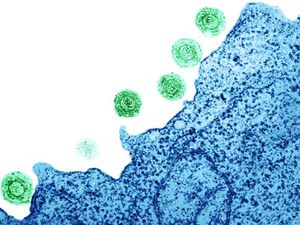Human Chromosomal Integration of Latent State Human Herpes Virus 6 (HHV-6): Difference between revisions
From MicrobeWiki, the student-edited microbiology resource
No edit summary |
No edit summary |
||
| Line 1: | Line 1: | ||
By: Kerri-Lynn Conrad | By: Kerri-Lynn Conrad | ||
[[Image:virus_01.jpg| | [[Image:virus_01.jpg|500x 500 px|right|thumb|Transmission electron micrograph visualization of Human Herpes Virus-6 (HHV-6) on the surface of a human lymphocyte. HHV-6 is the causative agent of roseola, a disease that effects nearly every human infant. [http://www.newscientist.com/gallery/mg20327200-virus-killer<1>]]] | ||
==Introduction== | ==Introduction== | ||
Revision as of 19:09, 1 November 2010
By: Kerri-Lynn Conrad

Transmission electron micrograph visualization of Human Herpes Virus-6 (HHV-6) on the surface of a human lymphocyte. HHV-6 is the causative agent of roseola, a disease that effects nearly every human infant. <1>
Introduction
Genomic Structure of HHV-6
HHV-6 Replication Cycle
Epidemiology
Pathophysiology of HHV-6 Infection
Initial Infection
Latency in Healthy Children and Adults
Reactivation in Immunosuppressed Individuals
HHV-6 Associated Disease States
Latency through Human Chromosomal Integration
Transmission through Germ Line
Future Work
References
Edited by Kerri-Lynn Conrad, student of Joan Slonczewski for BIOL 375 Virology, 2010, Kenyon College.
